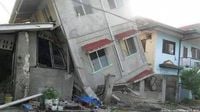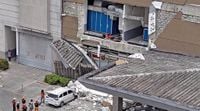In the early hours of October 11, 2025, the southern Philippines was rocked by a powerful magnitude 7.4 earthquake, sending shockwaves—both literal and figurative—across the region. The quake struck off the coast of Davao Oriental province, with its epicenter located near the municipality of Manay, at depths reported between 23 and 50 kilometers by different seismic agencies, according to Xinhua and the China Earthquake Networks Center. The tremor, which hit at 9:43 a.m. local time, left a trail of destruction and a community grappling with loss and uncertainty.
The human toll was immediate and devastating. At least six people lost their lives, with fatalities confirmed in Mati City (three), Davao City (one), and Pantukan—a mining town in Davao de Oro province—where two more perished, as reported by the Office of Civil Defense and multiple news outlets including Xinhua and Reuters. In Pantukan, tragedy struck as three gold miners were killed when a shaft collapsed during the initial tremor, rescue official Kent Simeon told AFP. In Mati City, disaster official Charlemagne Bagasol described the loss of one resident to a collapsing wall and two others to fatal heart attacks during the chaos. Another victim in Davao City was crushed by falling debris, highlighting the unpredictable dangers earthquakes bring.
Beyond the fatalities, the quake left hundreds more shaken. The Davao City Disaster Risk Reduction and Management Office confirmed that 347 people were treated for fainting or minor injuries. “All patients have received proper medical attention and are now in stable condition,” the agency assured on social media, as quoted by Xinhua. Hospitals and schools across the region sustained damage, forcing scenes of confusion as people rushed outdoors to escape falling debris. The Philippines’ Department of Education reported that the quake affected at least 12,000 schools nationwide, with classes suspended in 559 of them—an enormous disruption for students and teachers alike.
The physical destruction was widespread. Local media and social media users described the tremor as sudden and violent, with buildings and homes suffering significant damage. The Mindanao Sentinel shared videos showing extensive destruction at a high school, while roads cracked and power outages swept through affected districts. In Davao City, the usually bustling streets fell eerily silent as public transport halted and the local government suspended work and classes to assess the safety of structures. Police deployed mobile patrol units to ferry stranded commuters home at no cost, a rare but welcome gesture in a city struggling to regain its footing.
The initial quake was followed by a second powerful tremor several hours later. The Philippine Institute of Volcanology and Seismology (Phivolcs) reported a magnitude 6.8 offshore earthquake, also near Manay, at 7:12 p.m. local time and at a depth of 37 kilometers. The US Geological Survey measured this aftershock at magnitude 6.7. The back-to-back nature of these quakes amplified fears and complicated rescue efforts, especially as aftershocks—potentially as strong as magnitude 6.4—remained a looming threat, Phivolcs warned.
In the immediate aftermath, authorities scrambled to assess the danger of a tsunami. Phivolcs and the US Tsunami Warning System quickly issued alerts, warning that coastal regions could experience waves up to one meter or more above normal tides. The Pacific Tsunami Warning Center extended warnings to regions within 300 kilometers of the epicenter, including parts of Indonesia and the Pacific island nation of Palau. The US National Oceanic and Atmospheric Administration even forecasted waves up to three meters for threatened areas. Residents in coastal towns were urged to evacuate to higher ground, triggering scenes of panic as families fled their homes, clutching what belongings they could carry.
Fortunately, the worst-case tsunami scenario did not materialize. After only minor sea level fluctuations were observed, most warnings in the Philippines were withdrawn, and the Pacific Tsunami Warning Center lifted alerts for the archipelago, Palau, and Indonesia. “There is no longer a tsunami threat from this earthquake,” the Center announced, as cited by DW. Still, the psychological impact of the warnings—and the rush to safety—will likely linger long after the water has calmed.
President Ferdinand Marcos Jr. addressed the nation as reports of destruction mounted. “We are working round the clock to ensure that help reaches everyone who needs it,” he said in a statement, as quoted by DW. He added that authorities were assessing the situation and that search-and-rescue teams and relief operations would be deployed as soon as conditions allowed. The focus, he emphasized, was on both immediate recovery and the safety of those in affected communities.
The Philippines, as many know all too well, sits atop the Pacific 'Ring of Fire'—a volatile arc notorious for its frequent seismic activity. This latest disaster came on the heels of another deadly event: just ten days earlier, a magnitude 6.9 earthquake struck Cebu province, claiming 74 lives and injuring 559. The rapid succession of major quakes has stretched emergency response capacities and left many Filipinos anxious about what might come next. Phivolcs and local officials continue to urge vigilance, reminding residents to assess building safety, prepare for further aftershocks, and heed official advisories.
The economic and social impact of these quakes is still being tallied. Initial reports suggest significant damage to homes, buildings, and bridges, with infrastructure in need of urgent inspection and repair. Temporary power outages further complicated the response, especially in Davao City and surrounding areas. The suspension of work and classes, while necessary for safety, has disrupted daily life and commerce, with ripple effects likely to be felt for weeks or even months.
For many in the affected provinces, the events of October 11 will not soon be forgotten. The earthquakes have exposed vulnerabilities in building standards, emergency planning, and public communication, prompting renewed calls for investment in disaster preparedness. At the same time, the resilience of local communities has shone through—from first responders risking their lives in unstable conditions to ordinary citizens offering help to neighbors and strangers alike.
As the Philippines begins the long process of recovery, the lessons of this disaster are clear: preparedness and rapid response save lives, but long-term resilience will require sustained commitment from both government and civil society. The ground may have stopped shaking, but the aftereffects—both physical and emotional—will shape the region for years to come.


